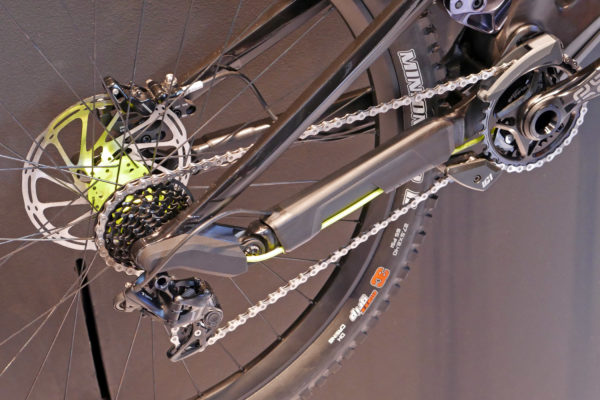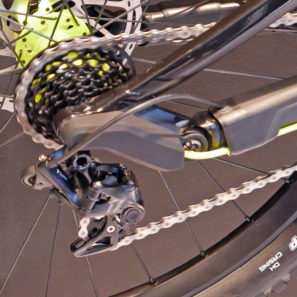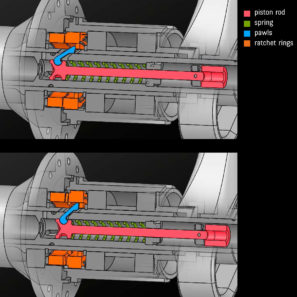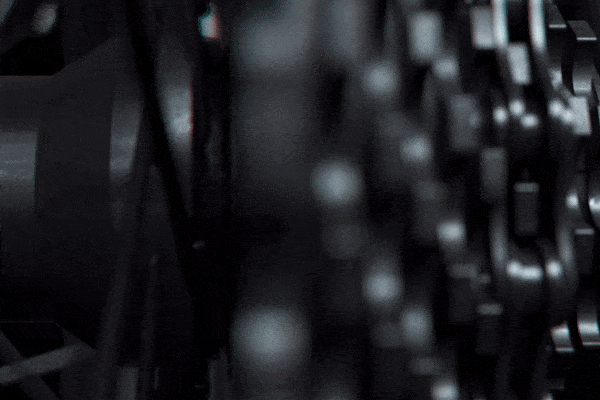OK, so Canyon’s not about to admit to that Aaron Gwin was a driver in their latest development since he races for their competition, but it isn’t a big stretch to think that Gwin’s World Cup win at Leogang last summer wasn’t a bit of inspiration for this project. Suspension designers, especially at the World Cup Downhill level, are continually balancing the way bikes move through their travel between anti-squat and pedal kickback depending on where their main pivot is located. Too much of one makes for a bike that either sinks riding through turns or on the other side loses suppleness in choppy sections of trail with your weight on the pedals. Canyon’s engineers figured out that they could get the best of both worlds by building in anti-suck, and then using a on-the-fly freehub disconnect that can remove all pedal feedback from the suspension at the push of a button. Check out how DisConnect could deliver a faster DH bike from one end of the run to the other…
A handful of elite riders have started to train chainless after Gwin’s win to try to both improve their flow and to see if they can impact the way their bikes. But what they also can realize is what suspension engineers look at when developing the kinematics of a bike, that is a frame performs differently whether rider weight on the pedals is stiffening the suspension or not.
Canyon’s thinking on this Project Dis\Connect bike was if they could turn on and off pedal feedback into the suspension system on the fly. When top-tier downhillers are separated by just a few hundredths of a second at the World Cup level, if they could develop a system that enabled a pro rider to switch pedal kickback on and off it could allow them to float through the rock and root gardens more quickly, and still be able to load the suspension and get that slingshot out of the berms that an anti-squat design delivers.
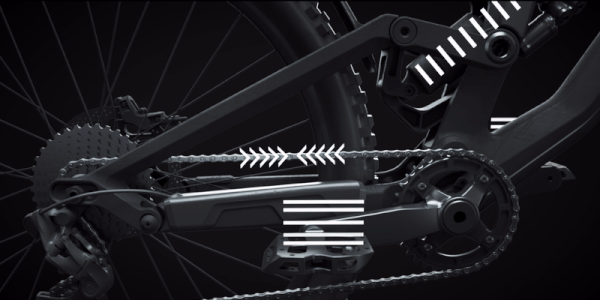
Their solution lets them design the suspension curve and anti-rise/anti-squat how they wanted it, while being able to temporarily eliminate all pedal kickback to let the suspension move as freely as possible on the roughest sections of track. The result is a bar mounted trigger remote and a rear hub that can decouple the freehub body so that it can spin freely in both directions.
In the regular Connected mode, the rear hub functions normally. The cassette rotates forward when you pedal, and coasts freely when you stop pedaling or back pedal. When the suspension compresses chainstay length grows, pulling back on the chain (which is now effectively too short) and wants to rotate the cranks backwards (as is happening above). With your weight on the pedals, suspension movement has to overcome your weight to compress, stiffening the suspension.

Then, at a touch of the trigger on the bar, the rear hub can disengage. In this Disconnected mode the cassette can rotate both forwards and backwards freely, independent of the hub, suspension, or cranks. With the pedals weighted and unmoving, the effective chainstay growth is accommodated by the cassette spinning back-and-forth (again check out the arrows on the cassette moving above). Now pedal pressure has no impact on the suspension, and the shock can move freely to best handle the terrain.
To make it all work Canyon developed a hub that holds a pair of ratchet rings together for normal operations, but can separate them by pulling the outermost one away and into the hub’s cassette body letting it spin freely both ways. A small shift mechanism mounted on the outside of the axle, reaches in and engages the outer spring-loaded ring with a rod and another set of spinning pawls to disengage it.
Opening up the internals, there are two ratcheted rings in the hub that make it work. The innermost ring functions like a normal hub and engages a set of pawls to give you the normal pedal forward/freewheel backward action. But then by having the second ring which is normally held in place with a strong return spring, Canyon can open up the connection from cassette to hub and let them spin separately.
The result: suspension movement decoupled from drivetrain input at the touch of a button.
When is it coming to a bike near you? No time soon. Canyon was quick to point out that this was one of the off-the-wall engineering exercises that they give themselves the freedom to pursue for the sake of a cool idea, and for which they have become known. Its application is extremely limited, with the hopes of picking up tiny fractions of a second that really only make a difference at the top of the race circuit. That said, it is an out of the box suspension design idea, and who is to say that it won’t trigger some other development that we’ll get to ride too.


